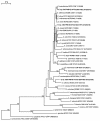Characterization of three new enterococcal species, Enterococcus sp. nov. CDC PNS-E1, Enterococcus sp. nov. CDC PNS-E2, and Enterococcus sp. nov. CDC PNS-E3, isolated from human clinical specimens
- PMID: 15004074
- PMCID: PMC356851
- DOI: 10.1128/JCM.42.3.1192-1198.2004
Characterization of three new enterococcal species, Enterococcus sp. nov. CDC PNS-E1, Enterococcus sp. nov. CDC PNS-E2, and Enterococcus sp. nov. CDC PNS-E3, isolated from human clinical specimens
Abstract
As a reference laboratory, the Streptococcus Laboratory at the Centers for Disease Control and Prevention (CDC) is frequently asked to confirm the identity of unusual or difficult-to-identify catalase-negative, gram-positive cocci. In order to accomplish the precise identification of these microorganisms, we have systematically applied analysis of whole-cell protein profiles (WCPP) and DNA-DNA reassociation experiments, in conjunction with conventional physiological tests. Using this approach, we recently focused on the characterization of three strains resembling the physiological groups I (strain SS-1730), II (strain SS-1729), and IV (strain SS-1728) of enterococcal species. Two strains were isolated from human blood, and one was isolated from human brain tissue. The results of physiological testing were not consistent enough to allow confident inclusion of the strains in any of the known enterococcal species. Resistance to vancomycin was detected in one of the strains (SS-1729). Analysis of WCPP showed unique profiles for each strain, which were not similar to the profiles of any previously described Enterococcus species. 16S ribosomal DNA (rDNA) sequencing results revealed three new taxa within the genus ENTEROCOCCUS: The results of DNA-DNA relatedness experiments were consistent with the results of WCPP analysis and 16S rDNA sequencing, since the percentages of homology with all 25 known species of Enterococcus were lower than 70%. Overall, the results indicate that these three strains constitute three new species of Enterococcus identified from human clinical sources, including one that harbors the vanA gene. The isolates were provisionally designated Enterococcus sp. nov. CDC Proposed New Species of Enterococcus 1 (CDC PNS-E1), type strain SS-1728(T) (= ATCC BAA-780(T) = CCUG 47860(T)); Enterococcus sp. nov. CDC PNS-E2, type strain SS-1729(T) (= ATCC BAA-781(T) = CCUG 47861(T)); and Enterococcus sp. nov. CDC PNS-E3, type strain SS-1730(T) (= ATCC BAA-782(T) = CCUG 47862(T)).
Figures


References
-
- De Graef, E. M., L. A. Devriese, M. Vancanneyt, M. Baele, M. D. Collins, K. Lefebvre, J. Swings, and F. Haesebrouck. 2003. Description of Enterococcus canis sp. nov. from dogs and reclassification of Enterococcus porcinus Teixeira et al. 2001 as a junior synonym of Enterococcus villorum Vancanneyt et al. 2001. Int. J. Syst. Evol. Microbiol. 53:1069-1074. - PubMed
Publication types
MeSH terms
Substances
LinkOut - more resources
Full Text Sources
Molecular Biology Databases
Research Materials

